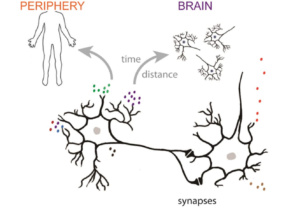Mechanisms that govern flexibility in the nervous system
Neuropeptides comprise the largest and most diverse class of neuromodulators, and they mediate integral processes ranging from energy homeostasis to behavior. These signaling molecules are secreted from neurons and transmit messages within the brain and between the brain and peripheral tissues. While their importance is well established, basic aspects of neuropeptide biology remain unknown because they can signal between cells not in physical contact and persist over long timescales.
Our lab investigates the spatial and temporal specificity of neuropeptide signaling in intact animals. We seek to determine where and when neuropeptides signal and how this is regulated; how their localization determines their function; and how this signaling relates to the anatomy of the nervous system. We want to understand how age-related changes in neuropeptide levels in specific tissues can influence whole organism health span and longevity, and to discover strategies to preserve these homeostatic signals with age.



